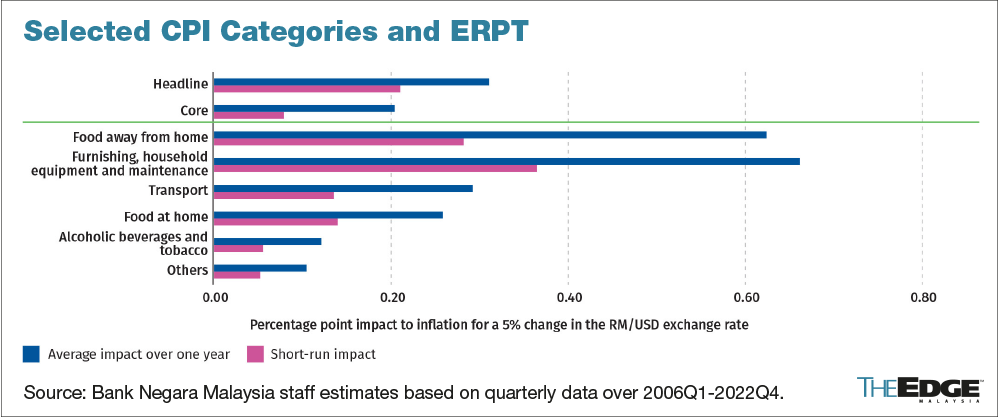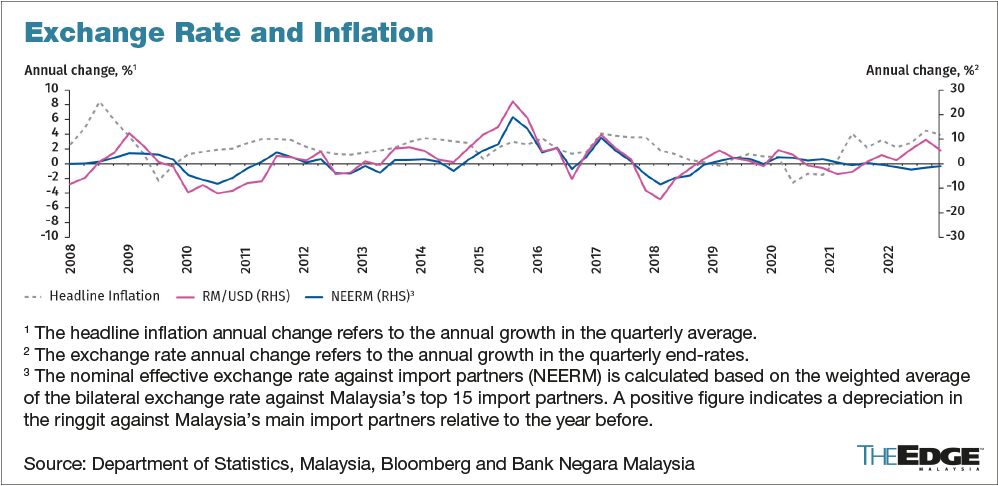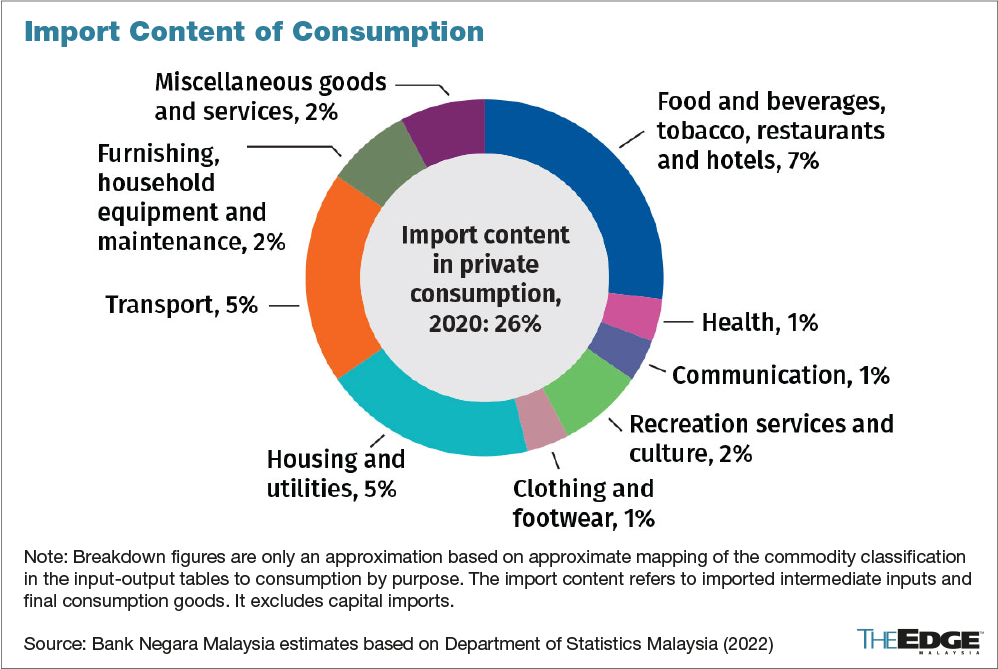
KUALA LUMPUR (March 29): The degree of the exchange rate pass-through (ERPT) to import price inflation in Malaysia was on average and within the findings from both advanced and emerging market economies, Bank Negara Malaysia (BNM) said.
The ERPT to consumer price index (CPI) inflation in Malaysia was also broadly consistent with findings among emerging market economies, the central bank said in its Economic and Monetary Review 2022 report released on Wednesday (March 29).
BNM said the ERPTs from changes in the ringgit/US dollar exchange rate to import price inflation and CPI inflation were empirically estimated using quarterly data from 2006 to 2022.
It said the ERPT estimation comprises two stages. The first stage is the pass-through to import price inflation, and the second stage is the pass-through to CPI inflation.
On the first stage, BNM observed that for a 5% change in the ringgit/US dollar exchange rate — the immediate ERPT to import price inflation is about 0.8 percentage points in the current quarter (short run) and 2.1 percentage points over a year.
The central bank observed that around 40% of the exchange rate impact is transmitted to overall import prices after a year, indicating that the degree of pass-through to import price inflation is in line with the findings for both advanced and emerging market economies.
“While dominant currency pricing would suggest a relatively high pass-through, the incomplete impact is influenced by other factors such as exporters’ pricing behaviour and contract revisions, driven by market structure of products, cost and demand,” BNM said.
Dominant currency pricing is a phenomenon when trade flows of internationally traded commodities such as crude oil and cereals are largely invoiced in US dollar, regardless the origin or destination of the trade.
Meanwhile, on the second stage, BNM observed that a 5% change in the ringgit/US dollar exchange rate is associated with approximately 0.1 percentage point change in core inflation in the next quarter (short run) and 0.2 percentage points over a year (long run).
“This is less than a full pass-through of import price inflation, and broadly consistent with findings on emerging market economies’ ERPT to CPI inflation,” the central bank said.
BNM stated that although these results are indicative of the average effects, they do not necessarily reflect significant changes in ERPT over time, differences in the effects of individual CPI items, and any averaging out of effects that could be caused by fluctuations in the exchange rate.
BNM stated that there is evidence that ERPT tends to be higher when the ringgit/US dollar exchange rate depreciates; a 5% depreciation results in the one-year ERPT to core inflation increasing to 0.4 percentage points (on average, it is 0.2 percentage points), though the short-term impact remains unchanged.
“In sum, ERPT to overall CPI inflation has increased marginally over time, reflecting differentiated impacts across relative prices, and tends to be higher during depreciation episodes. Nevertheless, it remains less than complete,” said BNM.
According to BNM, the ringgit depreciated by 5.4% against the US dollar in 2022. Peak to trough, the ringgit depreciated by 12.2% over January to Nov 4 in 2022 — when the ringgit depreciated from RM4.1665 at the end of 2021 to a low of RM4.7477 against the US dollar.
The import-weighted nominal effective exchange rate, which measures the ringgit’s performance against a basket of currencies of key import partners, appreciated by 1%, BNM said.
Malaysia’s share of import content in private consumption above emerging market’s average
BNM noted that CPI inflation could be affected by changes in import prices, according to the percentage of imported content in private consumption.
This includes direct imports of final consumption goods, which may still involve local distribution and transportation costs, as well as indirect imports of intermediate inputs that affect firm production costs.
Based on input-output tables, BNM said Malaysia’s share of import content in private consumption amounted to 26% in 2020.
“This appears to be slightly above average when compared to emerging market economies which showed regional averages of 15% to 25%, and close to 30% on average for advanced economies.
“However, this is not unexpected given Malaysia is a relatively open, upper-middle income economy,” the central bank said.
Exchange rate not seen as a predominant cost factor in firms’ pricing outlook
BNM reported that its regional economic surveillance programme showed that although the depreciation of the exchange rate was a major contributor to cost pressures in late 2022, the pass-through effect was partial.
It said firms have resorted to several initiatives to manage costs and price increases, including adjusting product design, negotiations with clients and suppliers, and increasing cost efficiency.
“Going forward, firms’ pricing behaviour will be shaped by unfolding developments surrounding both the demand and cost outlook. For the latter, the recent weakening of the US dollar, easing supply chain constraints and moderating global commodity prices would contribute towards normalisation of cost pressures,” BNM said.
The central bank said industrial engagements in early 2023 have indicated that there was less concern on the exchange rate compared to late 2022.
“The exchange rate was not seen as a predominant cost factor in firms’ pricing outlook. This observation was evident in both the consumer and industrial-oriented segments.
“Nevertheless, as conditions continue to evolve with regard to US monetary policy tightening, affecting exchange rate developments, the bank remains vigilant on how firms’ pricing behaviour may change given cost and demand conditions,” BNM said.
Don't miss the other highlights of the BNM Annual Report 2022. Read the articles here.



